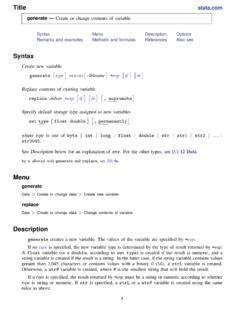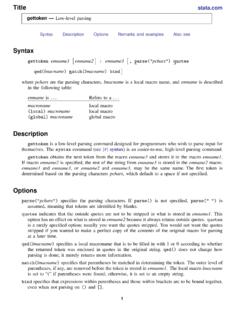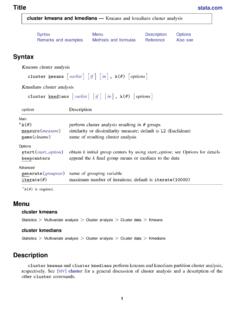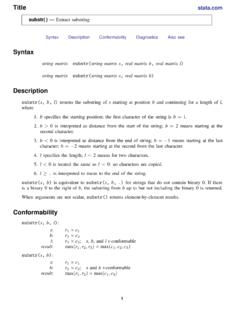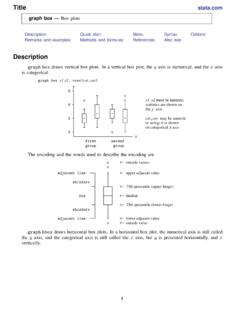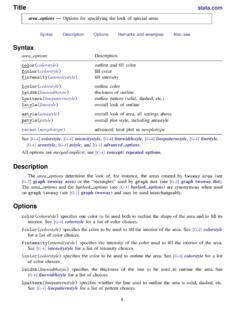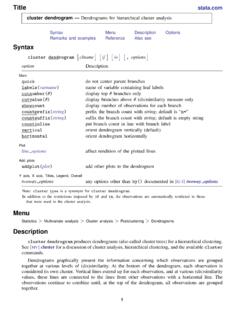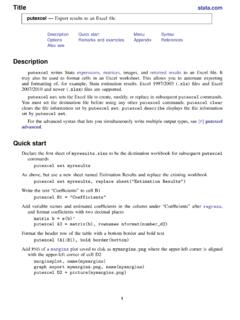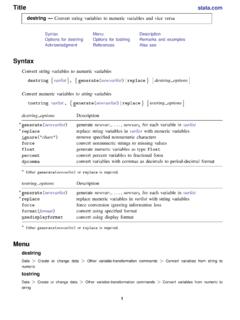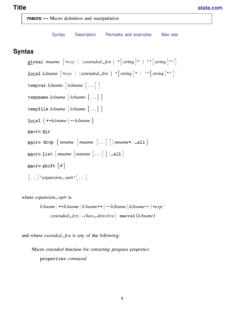Transcription of [SEM] Structural Equation Modeling - Stata
1 STATASTRUCTURAL Equation MODELINGREFERENCE MANUALRELEASE 13 A Stata Press PublicationStataCorp LPCollege Station, Texas Copyrightc 1985 2013 StataCorp LPAll rights reservedVersion 13 Published by Stata Press, 4905 Lakeway Drive, College Station, Texas 77845 Typeset in TEXISBN-10: 1-59718-124-2 ISBN-13: 978-1-59718-124-2 This manual is protected by copyright. All rights are reserved. No part of this manual may be reproduced, storedin a retrieval system, or transcribed, in any form or by any means electronic, mechanical, photocopy, recording, orotherwise without the prior written permission of StataCorp LP unless permitted subject to the terms and conditionsof a license granted to you by StataCorp LP to use the software and documentation. No license, express or implied,by estoppel or otherwise, to any intellectual property rights is granted by this provides this manual as is without warranty of any kind, either expressed or implied, including, butnot limited to, the implied warranties of merchantability and fitness for a particular purpose.
2 StataCorp may makeimprovements and/or changes in the product(s) and the program(s) described in this manual at any time and software described in this manual is furnished under a license agreement or nondisclosure agreement. The softwaremay be copied only in accordance with the terms of the agreement. It is against the law to copy the software ontoDVD, CD, disk, diskette, tape, or any other medium for any purpose other than backup or archival automobile dataset appearing on the accompanying media is Copyrightc 1979 by Consumers Union of ,Inc., Yonkers, NY 10703-1057 and is reproduced by permission from CONSUMER REPORTS, April ,, Stata Press, Mata,, and NetCourse are registered trademarks of StataCorp and Stata Press are registered trademarks with the World Intellectual Property Organization of the United is a trademark of StataCorp brand and product names are registered trademarks or trademarks of their respective copyright information about the software, typehelp copyrightwithin suggested citation for this software isStataCorp.
3 : Release 13. Statistical Software. College Station, TX: StataCorp ..1intro 1 .. Introduction2intro 2 .. Learning the language: Path diagrams and command language7intro 3 .. Learning the language: Factor-variable notation (gsem only)35intro 4 .. Substantive concepts42intro 5 .. Tour of models61intro 6 .. Comparing groups (sem only)82intro 7 .. Postestimation tests and predictions89intro 8 .. Robust and clustered standard errors96intro 9 .. Standard errors, the full story98intro 10 .. Fitting models with survey data (sem only) 102intro 11 .. Fitting models with summary statistics data (sem only) 104intro 12 .. Convergence problems and how to solve them 112 Builder .. SEM Builder 122 Builder, generalized .. SEM Builder for generalized models 125estat eform .. Display exponentiated coefficients 128estat eqgof .. Equation -level goodness-of-fit statistics 130estat eqtest .. Equation -level test that all coefficients are zero 132estat framework.
4 Display estimation results in Modeling framework 134estat ggof .. Group-level goodness-of-fit statistics 136estat ginvariant .. Tests for invariance of parameters across groups 138estat gof .. Goodness-of-fit statistics 140estat mindices .. Modification indices 143estat residuals .. Display mean and covariance residuals 145estat scoretests .. Score tests 148estat stable .. Check stability of nonrecursive system 150estat stdize .. Test standardized parameters 152estat summarize .. Report summary statistics for estimation sample 154estat teffects .. Decomposition of effects into total, direct, and indirect 155example 1 .. Single-factor measurement model 158example 2 .. Creating a dataset from published covariances 164example 3 .. Two-factor measurement model 169example 4 .. Goodness-of-fit statistics 177example 5 .. Modification indices 180example 6 .. Linear regression 183example 7.
5 Nonrecursive Structural model 187example 8 .. Testing that coefficients are equal, and constraining them 195example 9 .. Structural model with measurement component 199example 10 .. MIMIC model 208example 11 .. estat framework 215example 12 .. Seemingly unrelated regression 218example 13 .. Equation -level Wald test 222example 14 .. Predicted values 223example 15 .. Higher-order CFA 225iii Contentsexample 16 .. Correlation 232example 17 .. Correlated uniqueness model 237example 18 .. Latent growth model 244example 19 .. Creating multiple-group summary statistics data 251example 20 .. Two-factor measurement model by group 256example 21 .. Group-level goodness of fit 265example 22 .. Testing parameter equality across groups 266example 23 .. Specifying parameter constraints across groups 269example 24 .. Reliability 275example 25 .. Creating summary statistics data from raw data 279example 26.
6 Fitting a model with data missing at random 287example 27g .. Single-factor measurement model (generalized response) 291example 28g .. One-parameter logistic IRT (Rasch) model 297example 29g .. Two-parameter logistic IRT model 306example 30g .. Two-level measurement model (multilevel, generalized response) 314example 31g .. Two-factor measurement model (generalized response) 323example 32g .. Full Structural Equation model (generalized response) 330example 33g .. Logistic regression 336example 34g .. Combined models (generalized responses) 341example 35g .. Ordered probit and ordered logit 347example 36g .. MIMIC model (generalized response) 354example 37g .. Multinomial logistic regression 359example 38g .. Random-intercept and random-slope models (multilevel) 368example 39g .. Three-level model (multilevel, generalized response) 384example 40g .. Crossed models (multilevel) 392example 41g.
7 Two-level multinomial logistic regression (multilevel) 397example 42g .. One- and two-level mediation models (multilevel) 407example 43g .. Tobit regression 416example 44g .. Interval regression 419example 45g .. Heckman selection model 423example 46g .. Endogenous treatment-effects model 432gsem .. Generalized Structural Equation model estimation command 439gsem estimation options .. Options affecting estimation 443gsem family-and-link options .. Family-and-link options 447gsem model description options .. Model description options 452gsem path notation extensions .. Command syntax for path diagrams 455gsem postestimation .. Postestimation tools for gsem 459gsem reporting options .. Options affecting reporting of results 460lincom .. Linear combinations of parameters 462lrtest .. Likelihood-ratio test of linear hypothesis 463methods and formulas for gsem .. Methods and formulas 465methods and formulas for sem.
8 Methods and formulas for sem 478nlcom .. Nonlinear combinations of parameters 490predict after gsem .. Generalized linear predictions, etc. 492predict after sem .. Factor scores, linear predictions, etc. 496sem .. Structural Equation model estimation command 498sem and gsem option constraints( ) .. Specifying constraints 503sem and gsem option covstructure( ) .. Specifying covariance restrictions 505 Contents iiisem and gsem option from( ) .. Specifying starting values 508sem and gsem option reliability( ) .. Fraction of variance not due to measurement error 511sem and gsem path notation .. Command syntax for path diagrams 514sem and gsem syntax options .. Options affecting interpretation of syntax 520sem estimation options .. Options affecting estimation 521sem group options .. Fitting models on different groups 523sem model description options .. Model description options 525sem option method( ).
9 Specifying method and calculation of VCE 527sem option noxconditional .. Computing means, etc., of observed exogenous variables 529sem option select( ) .. Using sem with summary statistics data 532sem path notation extensions .. Command syntax for path diagrams 534sem postestimation .. Postestimation tools for sem 538sem reporting options .. Options affecting reporting of results 540sem ssd options .. Options for use with summary statistics data 542ssd .. Making summary statistics data (sem only) 544test .. Wald test of linear hypotheses 548testnl .. Wald test of nonlinear hypotheses 550 Glossary ..552 Subject and author index ..565 Cross-referencing the documentationWhen reading this manual, you will find references to other Stata manuals. For example,[U] 26 Overview of Stata estimation commands[XT]xtabond[D]reshapeThe first example is a reference to chapter 26,Overview of Stata estimation commands, in theUser sGuide; the second is a reference to thextabondentry in theLongitudinal-Data/Panel-Data ReferenceManual.
10 And the third is a reference to thereshapeentry in theData Management Reference the manuals in the Stata Documentation have a shorthand notation:[GSM]Getting Started with Stata for Mac[GSU]Getting Started with Stata for Unix[GSW]Getting Started with Stata for Windows[U] Stata User s Guide[R] Stata Base Reference Manual[D] Stata Data Management Reference Manual[G] Stata Graphics Reference Manual[XT] Stata Longitudinal-Data/Panel-Data Reference Manual[ME] Stata Multilevel Mixed-Effects Reference Manual[MI] Stata Multiple-Imputation Reference Manual[MV] Stata Multivariate Statistics Reference Manual[PSS] Stata Power and Sample-Size Reference Manual[P] Stata Programming Reference Manual[SEM] Stata Structural Equation Modeling Reference Manual[SVY] Stata Survey Data Reference Manual[ST] Stata Survival Analysis and Epidemiological Tables Reference Manual[TS] Stata Time-Series Reference Manual[TE] Stata Treatment-Effects Reference Manual:Potential Outcomes/Counterfactual Outcomes[I] Stata Glossary and Index[M]Mata Reference ManualvAcknowledgmentssemandgsemwere developed by command would exist without the help of two people outside of StataCorp.
